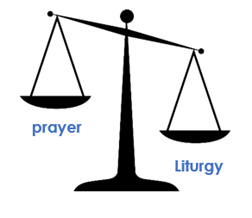As part of that conversation, I was asked to share some reflections. I offer some of them here because the questions concern us all and invite a response from us all.
The focus is on the first question on prayer from the Plenary Council agenda.
How might we become a more contemplative people, committing more deeply to prayer as a way of life, and celebrating the liturgy of the Church as an encounter with Christ who sends us out to “make disciples of all the nations”?
Who is the ‘we’ to whom the question is addressed? The answer lies in the opening statement of the Plenary Council agenda. The questions are addressed to the faithful, ‘the children of God, disciples of JC (who are) guided by the Holy Spirit’.
Two ways of praying
This is important to note because all forms of prayer and liturgy are a response to the experience of God’s loving presence. Prayer and liturgy are impossible and make no sense outside of faith. Prayer is relational or it is nothing.
What Vatican Council II says about liturgy is equally true about prayer … ‘People must be called to faith and conversion before they can come to the liturgy.’ (CLS a.9) It is interesting that in the scripture it is the disciples who ask Jesus to teach them to pray … not the crowds and not the followers, the disciples.
Our job as the faithful – the Church – is to proclaim the Good News of God’s love and to lead people to encounter Christ. Then, like Jesus we hang out with them, sharing our life of faith and waiting until they say, ‘teach us to pray.’
Appreciating the nature of prayer as response to the experience of Christ leads us to re-examine some of the hopes and suggestions we make – including in our Synod process.
The frame of the question reveals great wisdom, acknowledging that our becoming a more contemplative people involves two ways of praying:
a commitment to prayer as a way of life … AND
AND
celebrating the liturgy of the Church as an encounter with Christ that sends us out to ‘make disciples …’
It’s a very catholic question with its both/and approach. Becoming a more contemplative people requires a balance of both. What’s the balance like in your life?
Prayer as a way of life
Our Synod Paper reflects the need for us to develop our prayer life beyond the liturgy. In it we hear the people longing for more opportunities to pray, that are varied and interactive, and include faith sharing. There is a longing for parishes to become centres of prayer.
This longing acknowledges the truth that for prayer to become a way of life we must spend time praying – personally and communally.
Nurturing my personal prayer life is my responsibility. I am lucky to have many resources available to me that support and nourish my prayer life. I think the challenge of the question is for us to ponder how ‘we’ can support each other and open up the rich treasury of prayer that is part of our Catholic life and tradition. People are asking for support to find and experience different ways of praying so they might find what is ‘home’ for them, individually and together.
As an example, the form of prayer that I am learning about and finding a most enriching joy in my life is Mystagogical Reflection. I came across it ages ago through my exploration of the Rite of Christian Initiation of Adults (RCIA) but have only recently really discovered its inherent nature and am still learning how to reflect mystogically. Because Mystagogical Reflection is the central dynamic of the entire RCIA, I believe it has a natural home in the broader parish community.
Mystagogical Reflection is not only a rich form of prayer, it is the Catholic way for faith formation. It meets people where they are and is grounded in their personal experience of Christ in the scriptures, liturgy and life. It invites them to pay attention to that experience and to reflect on it in order to find meaning for life. In other words – it is Christ centred! Catechesis, or linking our personal experience and meaning to the wisdom of our living Catholic Tradition, happens in response to what is revealed in the personal encounter with Christ. Catechesis does NOT happen according to what I think people should know or some externally imposed ‘program’ that seeks to answer questions people haven’t even asked.
Mystagogical Reflection is an amazingly rich form of faith sharing and formation that leads to conversion. The final step is always focused on how I/we am going to live differently as a result of what Christ has revealed.
This is just one example of many forms of prayer and faith sharing that are part of our Catholic life and that some of us know little about. The Diocesan Liturgy Council and its associated groups, particularly the Christian Initiation Forum, wants to support people who are longing to experience more varied forms of prayer.
When we each and together have a rich, varied and meaningful prayer life beyond the liturgy, the liturgy is freed from the burden of carrying all our prayer expectations which we want met in one hour a week. Not only will the liturgy be freed, but we too will be freed from constant disappointment because the liturgy does not meet my often unrealistic and inappropriate expectations.
The Liturgy of the Church as an encounter with Christ who sends us out
Note the focus of the question is liturgy rather than only eucharist. Note too that it talks about the ‘liturgy of the Church’. Liturgy is something we – the Church – do together. It is not my private time with God. It doesn’t belong to me as an individual but to the Church.

I like to refer to the liturgy of the Church as a treasure chest, full to overflowing with the most beautiful opportunities to celebrate and encounter the mystery of God in relationship to all manner of life experiences.
I would love for our local Church to celebrate the liturgy of the Church in all its breadth and depth, wonder and variety, and power to engage people in all their joys and hopes, griefs and anxieties …
 Alas I find in many places a resistance to this – not just disinterest but resistance. Repeatedly, and often in the most inappropriate forums we act as if there is only one liturgy in the chest – Mass – and that there is no need to ‘read the signs of the times’ and therefore change our pastoral practice.
Alas I find in many places a resistance to this – not just disinterest but resistance. Repeatedly, and often in the most inappropriate forums we act as if there is only one liturgy in the chest – Mass – and that there is no need to ‘read the signs of the times’ and therefore change our pastoral practice.
To some degree I think this resistance is blocking a greater diversity of people from opportunities to celebrate meaningful liturgy as an encounter with Christ that sends them out.
And what of the liturgy as an encounter with Christ? Encounter with Christ in the liturgy is different to the encounter with Christ in non-liturgical prayer. In the liturgy we gather to encounter Christ together as members of his body. This encounter shapes us, changes us, converts us more deeply as members of the Church community, and sends us out on mission in the name of the community. We are sent to be living words of God and be a sacramental people embodying the love of God wherever we are.
We do not come to the liturgy to get something, to be consumers or to be entertained. We come to the liturgy together to join ourselves fully, consciously and actively to Christ in word and sacrament so that we will become more authentic and integrated members of the Body of Christ. We do this in the liturgy of the Church – as is made most explicit in the Eucharist – by handing ourselves over to God to be taken, blessed, broken open and given in love for the life of the world.
The liturgy is judged to be good, not by its adherence to rubrics, but by how we the Body of Christ live during the week.
We must come to celebrate the liturgy of the church as an encounter with Christ because in the liturgy, we the faithful, encounter Christ through our celebration and proclamation of the Paschal Mystery which is the source of the true Christian spirit; and what makes the Church in the image of Christ. (CSL a. 2, 14)
In the liturgy of the Church – in Christ – we learn the steps of paschal living:
- We gather in Christ with our brothers and sisters standing equal before God ... so we learn that all people are our brothers and sisters and we are to stand shoulder to shoulder with them …
- We mark ourselves with the sign of the cross … so we learn that the cross is our sign; that we are called to take it up, carry it and stand by it in the various circumstances of life
- We participate in greetings … so we learn that we are a people who greet others and respect them as people filled with the Spirit of God …
- We engage in dialogue … so we learn to live in dialogue with God and each other … listening first before responding …
- We are silent … so we learn the importance of silence and space in human life and relationships …
- We listen to God speak to us in the scriptures … so we train our ears to recognise the voice of God in the midst of the many voices we hear every day …
- We respond to the Word of God … so we learn the nature of faith as a response to our experience of God’s love and that indeed God’s love demands a response …
- We exchange a sign of peace … so we learn that we who have received the peace of Christ are impelled to share it with others …
- We are blessed … so we learn to live as a blessing …
- We process and sit and stand and kneel … so we learn that we are a pilgrim people … that we can never settle or rest for long in one place or one idea or one group of people …
The liturgy not only sends us out to make disciples, it sends us out to commit more deeply to prayer as a way of life.
We need the balance of a prayer life and the liturgy of the Church if we are to become a more contemplative people who are Christ-centred and missionary. Both are about becoming, conversion, renewal, formation, mission …

 How are we to make this a reality for the Church in Australia at this time?
How are we to make this a reality for the Church in Australia at this time?
How can we support each other in becoming a more contemplative people who are committed more deeply to prayer as a way of life, and to celebrating the liturgy of the Church as an encounter with Christ who sends us out in daring and bold delight at the power of God’s love to lift us up in wonder …?
Abbreviation
CSL: The Constitution on the Sacred Liturgy
Acknowledgements
Photo: © Louise Gannon
Scales: Image by Clker-Free-Vector-Images from Pixabay
Treasure chest: Image by Pezibear from Pixabay
Diamond: Image by OpenClipart-Vectors from Pixabay

